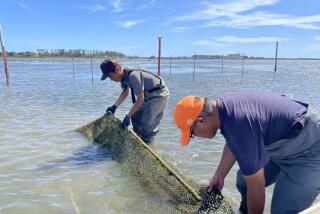Goal for Bangladesh: Long-Term Solution
- Share via
DHAKA, Bangladesh — With three-fourths of Bangladesh under water, some aid donors said Wednesday that it is time for long-term solutions in an impoverished land that becomes a vast flood plain every monsoon season.
“We have started thinking about the focus of our development aid,” a diplomat from one industrial nation said privately. “It doesn’t really make sense to pour millions into this country every year and see it washed away.”
Floods began in June with the annual monsoon season. They have claimed 416 lives by the government’s count, which is considered low, and 1,267 on the basis of unofficial tabulations by Dhaka newspapers.
The government said Wednesday night that all major rivers remained above flood stage but that water levels fell during the previous 24 hours in all rivers except two small tributaries near the Bay of Bengal.
But people still were marooned on rooftops and scarce patches of high ground, and as many as one-quarter of the nation’s 110 million citizens were homeless.
Wells and pumps have been submerged and people have begun drinking floodwater, causing a rise in diarrhea cases and fear of epidemics.
Officials say total damage and reconstruction needs cannot be assessed until the waters recede, but President Hussain Mohammed Ershad said the cost of rebuilding roads and railways alone will be $156 million.
Bangladeshi officials, donor nations and international organizations all say the most pressing need is a regional plan to stop flood waters that originate outside Bangladesh.
Water rushes down from the Himalayas each monsoon season in rivers that empty into the Bay of Bengal through the Bangladesh delta.
Ershad and other top Bangladeshi officials emphasize the need to work with neighboring India and nearby Nepal and Bhutan for a solution, but a senior U.N. official said he has pushed regional planning in vain for nearly a decade.
Until long-term steps are taken, major aid donors say they have no choice but to help feed the people of Bangladesh, who are among the world’s poorest, and provide medical assistance.
The United States, for example, is giving Bangladesh $131.5 million this year, including $73 million for food. The rest is for development assistance but generally goes for such things as health, family planning and agricultural research.
Washington has pledged $3.6 million of flood relief, but most already was in the pipeline as part of the annual aid package.
American flood relief consists of speeding up delivery of $2.5-million worth of wheat already in Bangladesh for distribution this year, plus $1.1 million in seed and contributions to relief funds.
More to Read
Sign up for Essential California
The most important California stories and recommendations in your inbox every morning.
You may occasionally receive promotional content from the Los Angeles Times.












